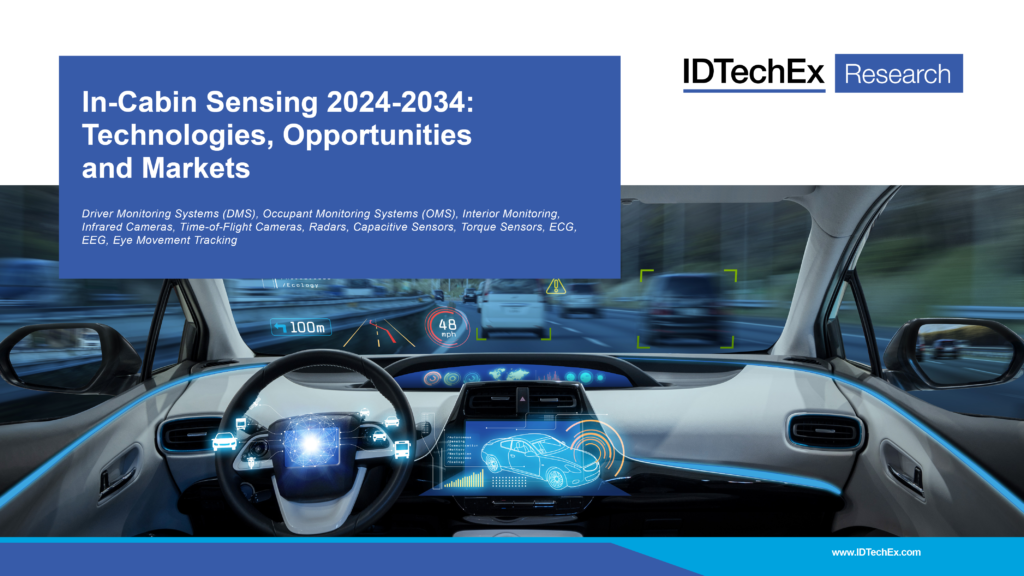For more information, visit https://www.idtechex.com/en/research-report/in-cabin-sensing-2024-2034-technologies-opportunities-and-markets/972.
Driver Monitoring Systems (DMS), Occupant Monitoring Systems (OMS), Interior Monitoring, Infrared Cameras, Time-of-Flight Cameras, Radars, Capacitive Sensors, Torque Sensors, ECG, EEG, Eye Movement Tracking
As the autonomous driving capabilities, specifically the SAE autonomous driving level, continue to advance, and with the imminent implementation of regional regulations such as Euro NCAP and the EU General Safety Regulation mandating driver monitoring systems (DMS), the global market for in-cabin sensing, encompassing driver monitoring, occupant monitoring, and advanced features like gesture control and vital sign monitoring, is projected to undergo an 11-fold increase from 2020 to 2034. This represents significant market opportunities.
IDTechEx’s report on In-Cabin Sensing 2024-2034: Technologies, Players and Markets provides a detailed market forecast for in-cabin sensing technologies, segmented by regions including Europe, China, the USA, Japan, and the rest of the world. The report presents a granular forecast of volume sales and market size for various sensors, including IR cameras, ToF cameras, radar, capacitive steering sensors, and torque steering sensors across different regions.
Regulations
In accordance with the EU General Safety Regulation, all newly manufactured vehicles falling under categories M and N are mandated to incorporate an advanced driver distraction warning system (ADDW) from mid-2024. The ADDW system primarily monitors the movements of the driver’s eyes and issues warnings if signs of distraction are detected. With the enforcement of this regulation looming within a year, IDTechEx has observed a prompt response from several automotive OEMs. For instance, as early as 2019, the BMW X5 was already equipped with driver attention cameras designed to observe the opening of the driver’s eyes and the position of the driver’s head, thus assessing the driver’s level of engagement.
While DMS is not a novel concept, traditional DMS typically rely on passive technologies that gather information from the vehicle, such as lane-keeping and driving duration, as well as steering sensors. However, these passive technologies have been shown to be prone to inaccuracies, leading to a high incidence of false positives. In addition, the ADDW regulation stipulates a shift towards actively monitoring driver eye movement, signalling a transition from passive to vision-based active technology.
Despite this transition, IDTechEx acknowledges that the current adoption rate of cameras in DMS, coupled with feedback from the European Automobile Manufacturers Association (ACEA) proposing the commencement of the ADDW system in July 2028, suggests that the widespread implementation of DMS in all new vehicles within categories M and N may extend beyond the initially stipulated mid-2024 deadline.
Apart from Europe, IDTechEx has identified comparable regulations in other key regions. For example, both the Association of Global Automakers and the Alliance of Automobile Manufacturers in the USA have voluntarily pledged to establish standardized rear seat reminders by 2025. In China, the Ministry of Transport has issued a directive titled “Notice of the General Office of the Ministry of Transport on Promoting the Application of Intelligent Video Surveillance and Alarm Technology,” outlining explicit requirements aimed at enhancing driver safety.
Driver Monitoring System
DMS can be classified into two categories: direct/active monitoring and passive/indirect monitoring. Passive monitoring relies on vehicle information such as driving duration and lane-keeping to evaluate driver fatigue, but it has the drawback of potentially generating false positives. On the other hand, active monitoring, prompted by the requirements of the ADDW, utilizes near-infrared (NIR) cameras, which are particularly effective for detecting eye movements without adversely affecting drivers. NIR cameras typically incorporate one or two LEDs and an image sensor, and they are strategically installed in locations such as A pillars and steering columns. Software plays a crucial role in extracting features such as eyelid closure and yawning to identify signs of driver drowsiness or fatigue.
Occupant Monitoring System
OMS are experiencing increased traction, propelled by regulations such as the U.S. Federal Communications Commission (FCC) mandating child presence detection (CPD) systems in new cars. OMS, equipped with advanced features like vital signal monitoring and gesture control, predominantly employ time-of-flight (ToF) cameras and/or radar. IDTechEx has seen both radars and ToF cameras being adopted in vehicles already, such as the Li Auto L9 utilizing ToF cameras and the Volvo EX90 incorporating radar modules.

A few examples of automotive OEMs and their sensing methods.
Market Opportunities
Regarding market opportunities, there is a clear trend toward increased adoption of DMS and OMS, driven by upcoming regulations and the emergence of innovative smart cockpit features. DMS is expected to experience rapid and widespread adoption, driven by regulatory mandates. In contrast, while OMS is also growing rapidly, it is foreseen to remain a premium feature predominantly found in mid- and high-end vehicles in the medium-term future. The swift rise of both DMS and OMS presents substantial opportunities for hardware suppliers, including sensor suppliers, chip makers, tier-one suppliers, and others, as well as for software solution providers. IDTechEx’s latest research report titled “In-Cabin Sensing 2024-2034: Technologies, Players, and Markets” provides a thorough analysis of the technological requirements and potential market opportunities in this domain. The research delves into the intricacies of the rapidly evolving landscape, offering insights for both hardware and software solution providers.


